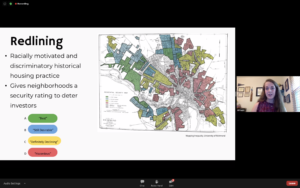Temperatures soared yesterday, but Allison Grant was cool and calm as she explained how climate change has disproportionately affected low income neighborhoods that are impacted to a greater degree by heat.
“Redlining was outlawed over 50 years ago,” said the UMW senior, citing the discriminatory lending practice that prevented minorities from purchasing homes. “Yet it continues to have a damaging impact on current communities, especially African Americans.”

Grant was among the 19 students who participated in the University of Mary Washington’s Summer Science Institute (SSI), which engages undergraduates in an intense 10-week research experience – in collaboration with their professors and peers – and provides a jumpstart on projects they’ll continue throughout the school year. The SSI Research Symposium, held virtually over Zoom for the first time, gave these young scientists the chance to explain their methods and findings to a wider audience.
Students from six concentrations – biology, chemistry, Earth and environmental science, computer science, mathematics and physics – displayed giant posters and delivered oral presentations. They discussed real world topics, from the reduction of carbon emissions during the COVID-19 pandemic and the use of statistical models to predict weather patterns, to pollinator insect diversity and more effective ways for computers to multitask.
“SSI is about providing an authentic research experience, and we’re fortunate that we can continue to give this to our students,” said Associate Professor of Chemistry Davis Oldham, who coordinated this year’s program with Assistant Professor of Mathematics Jeb Collins. “They’re still learning new skills, receiving faculty feedback and getting opportunities they could not get in a classroom setting.”
Hands-on learning is paramount at UMW – especially in the sciences – and some students were still able to do field work or rely on research they did before the pandemic. Sophomore Georgia Bowling collected samples from a neighbor’s pollinator garden for her research on the effect of green spaces on insect diversity, while junior Catherine Crowell used data she gathered last year from visits to bodies of water near a Richmond power plant.
The recently renovated Jepson Science Center provided a place for some students to conduct research while still observing social distancing measures. Henry Mills, a junior math and physics major, commuted from Richmond daily, preferring to study molecular alignment in Jepson’s spacious labs.
“The subject was totally unfamiliar to me,” said Mills, who first met advisor Varun Makhija at last year’s symposium, before the assistant professor of physics joined the UMW faculty. “As my knowledge has progressed, it’s become a really rewarding topic.”
Mills also worked virtually with a group at Stanford University, he said, and was excited when data matched for the two teams.
“It’s a good skill for students to learn, to share complicated ideas without being in the same space,” said Collins, the SSI co-coordinator and a mathematician who frequently collaborates with colleagues in different states and time zones.

Several projects were shelved when the pandemic hit, but Pamela Grothe seized the opportunity to delve into new research – and like many of her colleagues, shifted to projects that would better accommodate her students. The assistant professor of Earth and environmental science decided that redlining and climate change would be the perfect topic for Grant to pursue at home.
An environmental science major who recently enrolled in UMW’s new practical ethics minor, Grant was eager to combine her two academic interests – and connect with the Science Museum of Virginia’s chief scientist, Jeremy Hoffman. A published expert on the subject, Hoffman has committed to mentoring Grant as she continues her research.
Yesterday, she explained that redlined neighborhoods experience significantly higher temperatures than other communities. “Paved surfaces like concrete and asphalt trap heat and slowly release it in the evening, making the area even warmer,” Grant said, adding that trees have a cooling effect – but urban communities often lack green spaces.
To make matters worse, low income residents often can’t afford the high energy costs required to make their homes comfortable, Grant said. “As heat waves become more frequent and last longer, we need to change policies to help these vulnerable communities.”
She hopes her findings will pave the way.





Delighted that research continues despite Pandemic
Well done from one researcher to another
Jerri Perkins, MD
Such interesting projects… will the results of their research be published where we can read it? I’d love to see the results of their research…. for example… now I am wondering about the sex determination of turtles and how pollinators are affected by location…
Excellent. Keep up the great work. It must be difficult during Covid19 but inspiring to see the work move forward. I wish this was a largely platform as it is compelling and right before perhaps the most imporant election in our lifetime. Stay healthy. Cheers. Dave.